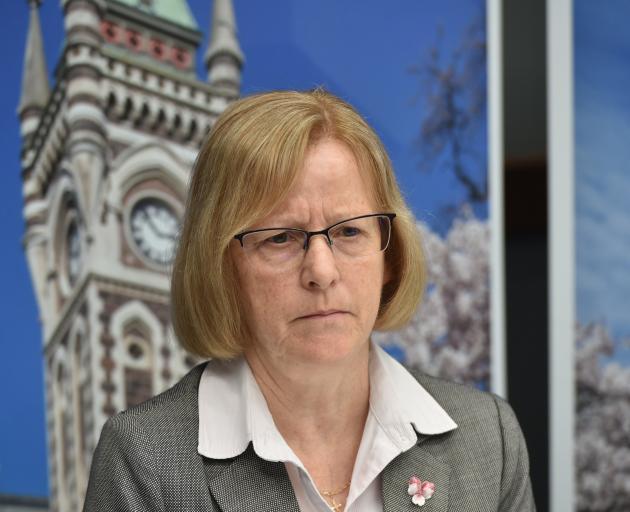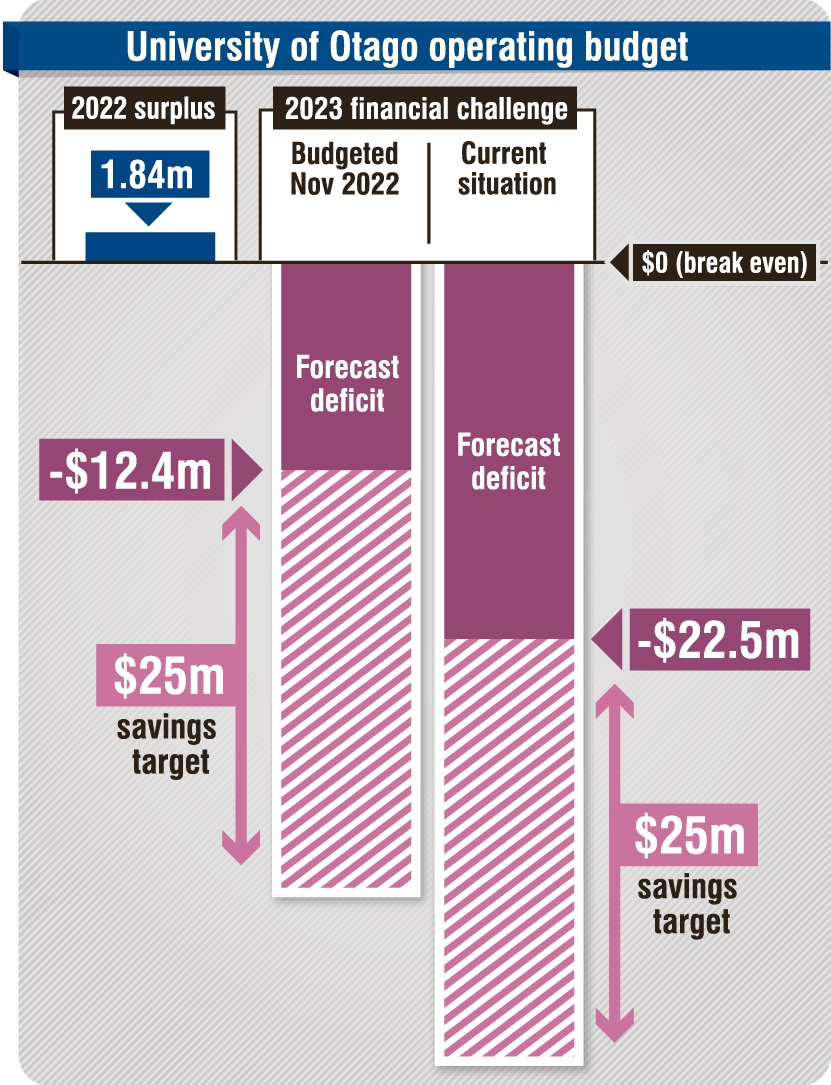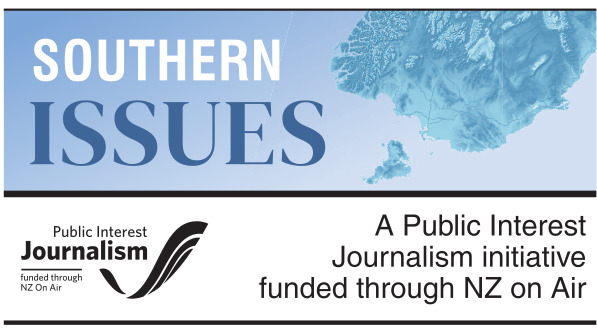
Next Friday is the deadline for university staff to put their hands up for redundancy. Announcing the bombshell in April that a $60 million annual budget gap needed filling — with salary savings a significant component — acting vice-chancellor Prof Helen Nicholson said the call for volunteers would likely be followed by a further round of redundancies, an expectation of several hundred staff leaving over the next 18 months and changes "across the university".
In a briefing for journalists, Prof Nicholson was asked about staff reactions: "As the days go by, staff may become more concerned and angry, potentially".
She was right. Staff and students painted their placards and marched in droves across campus.
Prof Nicholson’s April announcement followed a February warning delivered by vice-chancellor Prof David Murdoch, now on sick leave. A deficit was forecast, contingent on savings — but he did not put a number on the extent of savings required.
Prof Nicholson’s announcement painted a graver picture. Since February, the university was "worse off" and needed a new plan, she said.
She pointed to lower-than-anticipated enrolments of New Zealand students, including an increase in students dropping out after year one, as a primary cause of the worsening, while also indicating the university had forewarning due to multi-year under-funding by government.
"The situation has been signalled for a long time — years ... we are facing an accelerating situation that needs an immediate response," she said.
This week, in a lengthy written missive sent to staff about the financial woes, Prof Nicholson stressed that in April the news about student enrolment numbers "had tipped the situation to the point of significant urgent action" being required.
The message was three-fold; we knew it was coming, it has got worse quickly, and now it is panic stations.
Staff are loath to talk on the record about the university’s leadership team, at a time of job loss threat — but talk openly about uncertainty and fear created by the April announcement.
Speaking about the mood across campus, Prof John Reynolds, department of anatomy, said: "There is a tremendous opportunity to be a Te Tiriti-led university in line with the university’s 2040 vision — but until we know the plan, the waters are muddied with high anxiety and fear of people losing their jobs."
Tertiary Education Union (TEU) branch president Craig Marshall told the Otago Daily Times: "It is fair to say staff interpreted the news in April to mean $60 million savings were needed to support 2023’s end-of-year position. Staff were, and still are, utterly baffled and alarmed about how this figure has been arrived at and how it could be saved to affect 2023’s bottom line, and what further savings may be needed in 2024 and beyond. They are scared." Fifty-five percent of the university’s operating costs are salaries.
A $60million saving from 2023’s $834.4 million operating budget was a huge 7%. Did this mean 7% of staff (1 in 14) would be cut? The "several hundred roles" announcement suggested "yes" — 7% of 4000 staff is 280.
Staff worried job cuts might need to be deeper, because the university was already four months into the year, and because there were costs associated with slashing staff, such as redundancy payments.

As well as jobs, it seemed everything was potentially up for the chop by Prof Nicholson and her team. In the April announcement, academic programmes were implicated — the university needed to "do less, better". The university’s capital expenditure programme, for new buildings and building refurbishments, would be "significantly impacted". Asset sales were being considered.
Staff say that, because of uncertainty and worry, there is a "fragile environment" and staff are voting with their feet. University chief financial officer Sharon van Turnhout, who is retiring next month, says this is happening "due to amazing opportunities and salaries" elsewhere.
However, Dr Marshall responded: "A lot of people are considering their future with the university and some have already left, or are going, partly due to pay rates but now also job security fears. New people are appearing who take up training time, which in itself is costly."
An Official Information Act request answer shows a 70% rise in staff turnover from 8.7% in 2020 to 14.8% in 2022.
Staff have told ODT they are confused about the urgency to save in the midst of a building programme and recent increases in staff. Staff numbers have risen from 4272 (full-time equivalents) in 2017 to 4355 in 2022, despite a "support services review" in 2018 that aimed to create more centralised services requiring fewer staff. Staff have increased most in non-academic roles.
When asked by ODT if the university had a financial management plan, Miss van Turnhout said the university had a long-range financial forecast, but not a financial plan.
"The union and staff would welcome a much clearer understanding of the financial deficit — and what this means for staff," Dr Marshall said.
An ODT investigation has uncovered that the university’s leadership team knew about the need for most of the required savings last year — but kept this information away from staff.
The operating budget for 2023 was prepared November 2022 and was dependent on making $25 million savings to reach a 2023 year-end position of a $12.4 million deficit. In other words, a $37.4 million hole was already forecast for 2023 at that time — as well as significant planned debt due to the building programme.
The university’s presiding council agreed to the savings and approved the budget, Miss van Turnhout said.

It does not, however, explain the $37.4 million funding hole in the operating budget, nor the budget’s reliance on making $25 million savings to prevent a larger year-end deficit.
Buried in the narrative, it mentions budgeted savings of $12.8 million in salaries and related costs, indicating that, back then, the university already had a focus on staff savings.
When asked why the $37.4 million funding hole and target of $25 million savings were not explained in the budget, Miss van Turnhout said: "The budget document is publicly available, and the decision was made that we would not include this detail while we worked through how $25 million [savings] would be achieved."
This response belies the fact that the university knew all along that the source of the $25 million savings would only be "worked through" during the year by its various department chiefs.
The $25 million was a "target" for savings — not a plan.
"In recent years, savings targets have been required to achieve the budget, approved by the university council," Miss van Turnhout said.
"They have always been informed of the level of savings targets assumed within the approved budget, and the university community has always delivered the required savings by the end of each calendar year."
The startling, and hidden, difference between the budget for 2023 and prior budgets was a doubled savings target, plus the $12.5 million predicted deficit position if the target was reached.
In 2021 and 2022, the savings targets were about half the size ($12 million and $14 million).
ODT has obtained the university’s financial statements for the first three months of 2023. They show the university is now worse off — by about $10 million — than the budget had forecast. Prof Nicholson had, in April, indicated to the ODT that the position had worsened by $20 million due to the fewer students than forecast.

The updated figures do little to change the overall picture — it was bad back in November, and it is bad now.
A university spokeswoman told ODT that the summer holidays prevented announcements to staff.
Speaking for the union, Dr Marshall responded: "It is very disappointing that the position was known last November and not communicated then. It is better to get information out there, than hold it back. Staff should have been given the opportunity to be involved before the end of last year and have their ideas heard over months. Staff also contact us regularly and say they are finding it hard to communicate their ideas to leadership. They don’t know the mechanism.
"Keeping the holidays anxiety-free is a fair point, but I think it is better to let people know these things and let them work out their feelings about it, rather than to keep them in the dark — however good the intentions."
Five months into 2023, it is still unclear how savings will be made — with the exception of the voluntary redundancies.
Contrary to Prof Nicholson’s announcement which indicated staff cuts ahead, Miss van Turnhout told ODT: "No decisions have been made to target staffing cuts specifically — at present, all discussions have been for a variety of mitigating actions, and staffing reduction targets have not been agreed."
The problem is getting pushed down the road.
The university had made "some progress" to reach the $25 million savings target, but savings so far were mostly "temporary in nature" such as salary savings when staff left, and therefore savings would "need to be found permanently in 2024", Miss van Turnhout said.
A further, significant, hole is likely therefore to be forecast in 2024’s operating budget — but its level is dependent on any progress making savings this year. Any redundancies that occur in 2023 would, for example, reduce the 2024 hole.
"We are looking at budgets and some assessment has been done of options, but these things take time. For example, if we look at selling assets, some have to be offered to Ngāi Tahu and consulted on before the open market.

University director of strategy, analytics and reporting David Thomson confirmed there were still "ongoing constant discussions" at senior leadership team level, meeting every fortnight to discuss and consider how they determined which appropriate mitigating actions to take.
Prof Nicholson told staff in the April announcement that a seven-year "strategic plan", called Pae Tata — Strategic Plan to 2030, was "being developed" and would go to the university’s council in May.
Another all-staff forum would be held to outline the plan and provide direction on where the university would "increase revenue and cut costs".
When pressed about the plan’s publication, Mr Thomson told ODT that the plan had been discussed in the May council meeting, but would not be finalised until after June, when the council next convened.
Although in an acting role, because of the vice-chancellor’s sick leave, Prof Nicholson is not a new kid on the block.
She was also acting vice-chancellor for nearly a year in 2021 when there was a gap between vice chancellor appointments.
When asked in the April briefing for journalists if she would consider stepping down from the role, there was, understandably, awkward laughter in the room, as she had only just stepped up.
Her answer suggested she considered her "acting" role more of a poisoned chalice than an opportunity to lead a large team successfully through challenging times.
"I am acting vice chancellor and I was hoping I might retire soon. It is not the most comfortable position, no," she said.
When asked to comment for this article on the situation staff face, she added: "And of course it is uncomfortable for everyone involved".








